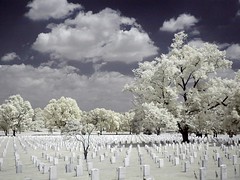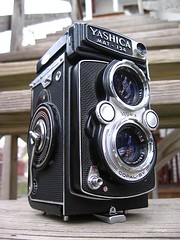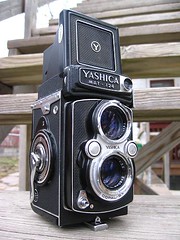Assignment 11: Do Something Different
Previous Assignment: Still Life
Are you looking for something different in your photography? Sometimes, working with different equipment can give you inspiration and motivation to take more pictures, and it will force you to think outside the box you've become comfortable with.
One way to do this is to try out a Holga camera. This Wikipedia article has this to say about the iconic Holga:
The Holga is a very inexpensive, medium format box camera appreciated for its low-fidelity aesthetic. . . . The Holga's cheap construction, combined with poor quality materials and simple meniscus lens often yields pictures that display vignetting, blur, light leaks, and other distortions. The often bizarre photographic results of these effects have ironically popularized the camera with an international audience, and Holga photos have won numerous awards and competitions in art and news photography.An eBay search at the time I write this turned up several Holgas available for under $40 US. The Holga uses medium format film, not 35mm, so the shape of the pictures is different--a great way to make you think differently about photography. Also, the distortions and vignetting caused by the poor construction should make your results even more interesting than you might expect. Some photographers like to try to figure out exactly how any particular Holga might distort the picture, and try to use that to their advantage. Many Holga enthusiasts own several different Holgas (or perhaps even dozens of them), all of which distort pictures in different ways. Holgas also offer many opportunities to modify them.
Another good way to force yourself out of your comfort zone is to get a new lens, or lens filter, or some other piece of equipment that will change the way the pictures will turn out. I've done this a couple times--first when I got my wide angle lens, and second when I got my digital camera.
But if you don't want to make that kind of investment, you might try a different kind of film, such as infrared film. I haven't tried this yet (but I think I might real soon), but here's an example of what it looks like:

(by Cocoabiscuit)
You might want to do some research on what kinds of subjects and atmospheric conditions will give you interesting results, and how to determine correct exposure (trial and error, mostly) before you go out with IR film, and this Wikipedia article is a good place to start. There is also such a thing as ultraviolet photography, but it's much less popular and I believe it requires special filters.
EDIT: I have added a link to a FAQ on infrared photography that appears to be very in-depth, in case you're interested. The link is in the sidebar.
Another way to use film to force you outside your box is by using ultra-high speed film (such as 800 or 1600 ISO film) to put a lot of grain in your shots. To take this to the next level, you can use high speed film, but tell your camera that it's a faster speed than what's really in there (for example, use 800 ISO film and tell your camera it's 1600 ISO). Then you'll have to take it to a nicer photo lab (sorry, not Walgreens) and tell them to push process it.
If you don't have a film camera, you can use a one-time-use camera with a higher speed of film. Even if you do have a film camera, you might want to try this out. There are many things you ca do with one-time-use cameras. There are underwater ones and panoramic ones, and this article has information on modifying them to be pinhole cameras, rather than using a lens, or on reloading them with different film (including infrared film).
I don't have any examples to share with you this week, but a friend has just given me a medium format twin lens reflex (or TLR) camera that I'm going to play around with. It's a Yashica MAT - 124, which has a 1:1 aspect ratio (using medium format film, which is 6cm wide, it produces negatives that are 6cm by 6cm).


This will force me outside my comfort zone for a number of reasons. First, it takes square pictures, so I can either think about each picture as a square, or plan a crop for each picture that may be different from the normal aspect ratio that I'm used to. Second, the viewfinder is quite different. You look in the top of the camera, so you hold it at chest or waist height, quite different from the eye level that I'm used to. It also shows everything in reverse (if you move the camera left, the image moves right). And finally, it's a lot more work to use a completely manual, TLR, medium format camera like this, especially when compared to a digital point-and-shoot like I'm used to, so a lot more planning will go into each shot.
When you try something different, why don't you share it with the group, and explain what you did differently?

2 Comments:
I have a Bronica ETRs that I used before going digital with an EOS 10d about two years ago.
A few weeks ago I dug it out, just for the hell of it. Put a new battery in, loaded it with some film, grabbed the light meter and away I went.
It was quite a challenge having got used to do-it-all-fo-you digital.
One of my favourite shots with the camera is this one:
http://www.flickr.com/photos/cornellfinch/103553315/
That's a very cool shot.
Post a Comment
<< Home